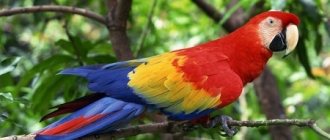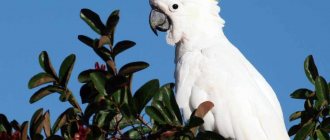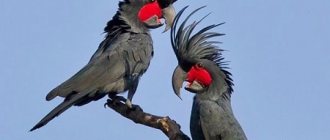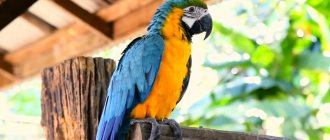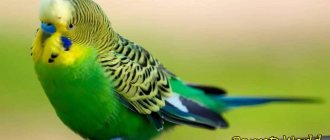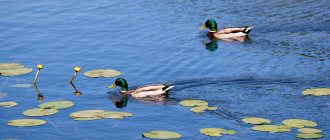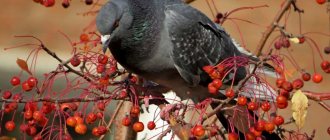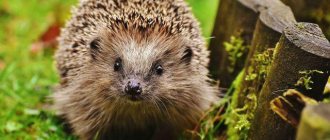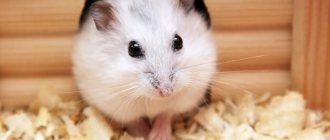In the cockatoo family, all parrots are unusual, interesting and beautiful, each in their own way. The pink cockatoo is not far behind the others - a cute bird with original colors and funny behavior. In its homeland, Australia, the pink parrot acquired a negative reputation, and also received the nickname Galah from local residents, that is, “clown”, “boob”. You will find out why this happened by reading the article.
Appearance and character traits
The plumage of pink cockatoos combines two primary colors: gray and pink. The feathers on the back, wings and tail are colored in pearl shades, darker at the tips. The belly, sternum, and neck are pink. The undertail is almost white. The skin on the paws is smoky gray. The underside of the wings is two-colored: the long flight feathers are dark gray, the shoulders are red. The eyes are small, black, framed by folded leathery circles. Ivory beak.
There is a pale pink crest on the head. With its help, the cockatoo parrot expresses its emotions. In a calm state, the cowlick fits tightly to the crown and back of the head. When the bird is excited, the crest rises and becomes fluffy.
Gala is slightly smaller in size than other representatives of the Cacatuidae family and is considered one of the smallest. On average, the bird grows to 35-36 cm, weighing 300-350 g. Males are slightly larger than females. It is difficult to determine gender differences based on appearance. However, this can be done by eye color: in a bird aged 2-3 years, the iris darkens, acquiring a deep black tint in males, transparent brown in females.
Cute appearance is not the only positive quality of the Gala parrot. Regarding character, we can say that the “clown” is the softest and most flexible in the family. He is also playful and artistic, fully living up to his nickname. The pink cockatoo will be welcome in families with children. This parrot does not show aggression towards people and can make a wonderful pet.
Description of the pink cockatoo
Body size is 35 cm. The weight of a female is 0.3 kg, and that of a male is 0.35 kg. Wing length – 28 cm. Tail length – 15 cm. The color of the bird is contrasting. The throat, chest and belly are pink-red. The frontal part is light pink. The rest of the head is pinkish-red.
The back is ash-gray, and the loin is gray-white. The flight wings have a brown color, while the tail wings have a dark brown color. The crest is small. The beak is light gray. The area around the eyes without feathers is bluish or pinkish. Legs dark gray.
Pink cockatoo: photo.
Lifestyle in nature
The habitat of pink cockatoos is mainland Australia and adjacent islands, including Tasmania. Parrots inhabit lowland areas, but are also found in mountainous areas. The exception is the ocean coast, where these birds do not appear. They love eucalyptus thickets, low-lying woodlands, and shrubs. During periods of drought, they wander around the continent, moving closer to bodies of water. They lead a gregarious lifestyle. Usually the size of the flock does not exceed 1000 individuals.
Gala parrots have the same feature as all cockatoos - they fly well, but on the ground they move slowly, with a dancing gait. They hide from their enemies in dense crowns, where they wait out the period of intense heat. They feed on fruits and nuts. Descending from the trees, birds look for edible shoots, buds, seeds in the grass, and get roots. Insects are often the prey of cockatoos. When there is a bad year, fires or drought leave the birds without food, the cockatoos go to the fields. Well-kept farmland attracts them, but such raids are fatal to parrots. Crop owners exterminate pest birds, but the population does not suffer from this.
Diseases of the pink cockatoo
Most often parrots get sick:
- obesity;
- lipoma;
- liver cirrhosis;
- prolapse of the cloaca;
- candidiasis;
- psittacosis;
- mycosis;
- sarcocystosis;
- liver lipidosis.
If a cockatoo is plucking feathers or acting unnaturally, it is necessary to take it to a veterinarian for further diagnosis. After passing the tests, the doctor will prescribe treatment.
Reproduction and lifespan
Living in a flock, the pink cockatoo finds a mate, and this union remains strong until the end of the birds' lives. An interesting way of courting a “clown parrot”: the male raises his crest, opens his wings and dances around the female he likes. At the end of the mating rituals, the partners build a nest in the hollow of an old tree. Males try to choose a hollow as high as possible so that predators and snakes do not reach the brood. The birds tear off the bark and throw it, along with thin twigs and leaves, to the bottom of the hollow, preparing a comfortable bedding.
After fertilization, the female lays 2-5 eggs, one per day. The duration of incubation is approximately 27-30 days, and both parents warm the clutch. When the chicks hatch, they remain in the nest for 2-3 months, then begin to fly, but begin to live independently only after six months.
Did you know? Pink cockatoos provide "kindergartens" for their chicks. During the day, young animals are under the supervision of elderly individuals, and at night the birds fly to their nests.
The chicks find it difficult to survive among the many dangers of the wild. About half of them die in the first six months of life, and only one in ten survives to three years. Despite the fact that the pink cockatoo does not have a protected status, the life expectancy of this parrot in the wild is quite long - about 20 years. At home, Gala can live up to 50 years.
Spreading
The habitat covers almost the entire territory of Australia, the eastern part of Tasmania and on some islands located near the Australian coast. The most numerous populations live in the central part of the continent.
Presumably the original habitat was west of the Great Dividing Range and extended to the south-western regions of Western Australia. Pink cockatoos inhabited kwongan, a type of Australian heathland that contains sclerophyte shrubs and isolated small trees.
In the second half of the twentieth century, birds began to massively explore new territories. Their population has increased especially sharply in the southwest of the country in the so-called wheat belt. Gala settle near fields with grain crops, causing significant damage to farmers.
Now they are found in almost all types of open landscapes, confidently colonizing coastal and mountainous areas. In the mountains they are observed at altitudes up to 2500 m above sea level.
There are 3 subspecies. The nominate subspecies is distributed in Western Australia from the arid Pilbara region to the Great Sandy Desert and north-west coast.
Keeping at home
Owners of cockatoo parrots note that these birds feel great in captivity. The peaceful pink cockatoo can easily become the best friend for its owner. True, exotic birds have special needs - a comfortable microclimate, constant employment and increased attention from people. This parrot is not able to remain alone for long. We will discuss further what else a sociable pet needs.
Selection and arrangement of the cage
A medium-sized parrot will need a spacious cage. The bird needs to move a lot to maintain physical shape. The optimal dimensions of the home are 90/90/110 cm, but this is in the case of single living. Two parrots will need increased housing.
Parameters of a good cage:
- durable material (steel rods with a diameter of 3-4 mm);
- longitudinal-transverse design with a cell size of 3x3 cm;
- rectangular shape;
- curved roof with the ability to open completely;
- main door with a convenient accessory;
- additional door for easy cleaning;
- pull-out tray;
- rollers or wheels with which the cage can be moved.
In the cage you need to secure wooden perches 2.5-4 cm thick, located at an angle to each other, so that the bird walks as if on branches. Cockatoos also like to hang upside down, clinging to branches with their claws. When installing perches, you need to take into account this need of pets and choose the right height.
On a note! So that the bird has the opportunity to rest in the middle of the day and hide from prying eyes, a small house is hung in its cage.
Adsorbent material is poured onto the bottom of the cage - sawdust, pieces of writing paper (not newspaper). This will make cleaning more convenient. In addition to hygiene, you need to think about keeping your pet entertained. For this there are various toys, rings, ropes and ladders. The intelligence of the pink cockatoo allows it to be trained, taught tricks and sound pronunciation.
What to feed
A tropical forest dweller needs a variety of foods. At home, it is customary to feed parrots with specialized grain mixtures. More than half of the daily diet should come from dry foods - cereals and seeds. For the pink cockatoo, food that contains a minimum of fatty components is suitable. This bird is prone to obesity, so its diet must be monitored carefully.
Succulent food is necessary, as are grain ingredients. Feathered “clowns” can eat boiled and raw vegetables, herbs, and fruits:
- cauliflower;
- carrot;
- tomatoes;
- pumpkin;
- Bell pepper;
- apples;
- pears;
- papaya;
- mango;
- bananas;
- citrus fruits without peel;
- dandelion leaves, green salad.
Occasionally you can pamper your pet with sprouted grains and milk corn. Parrots love to peck boiled eggs, but you can add them to the menu no more than once a week.
Cockatoo parrots are fed twice a day: two teaspoons of grain mixture are poured into the feeder, chopped vegetables and fruits are served in a separate container. Fresh food should not be left overnight, otherwise it will spoil (there is a risk of poisoning the bird).
Price and purchase features
It is best to buy expensive ornamental birds in a nursery, from professional breeders, but not on private offer websites. When buying a cockatoo from an advertisement, no one can vouch for the health and behavior of the bird. It is likely that in this way the owner wants to get rid of a pet with a bad character.
When choosing a parrot, take a closer look at its appearance:
- A healthy cockatoo has clean, neat, dense plumage.
- There is no discharge from the eyes.
- There are no large chips, cracks, or growths on the beak.
- No signs of feather loss.
- The parrot behaves actively, and does not sit ruffled.
Such an exotic bird as the pink cockatoo costs a lot. You will have to leave at least 200,000 rubles if you take the chick from a nursery. But the high cost in this case is justified: there is a guarantee of the purity of the breed, absence of diseases, and availability of vaccination. In addition, a parrot bred by professionals and fed from birth is better tamed.
For home keeping, people rarely choose pink cockatoos, preferring white-crested or yellow-crested cockatoos. However, the beautiful, sociable, intelligent cockatoo Gala is in no way inferior to his brothers. This bird is not vindictive, peaceful, affectionate and calm. She gets along well with other birds and next to humans.
